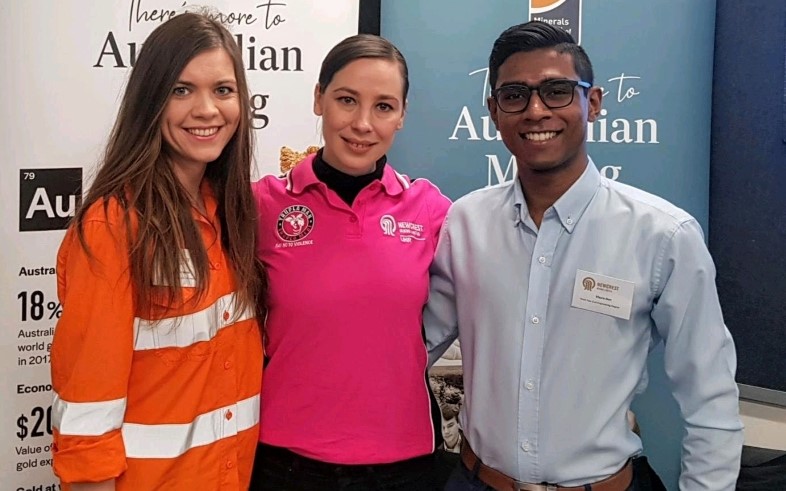High school stars at Swinburne published in international space journal

Visura Lokuge Don (right) is now working as a geotechnical engineer at Newcrest Mining since working on the journal article
In summary
- Research conducted by a group of high school students with Swinburne’s Centre for Astrophysics and Supercomputing (CAS) has been published in the journal, Galaxies
- The article was written by high school work experience students Visura Lokuge Don, Lochlan Bull and Kazuki Kuhlmann, alongside Professor Alister Graham and undergraduate scholarship student Katherine Kenyon
- The students collaborated with experts as part of a long-running program that supports the next generation
Research conducted by high school and undergraduate students at Swinburne’s Centre for Astrophysics and Supercomputing (CAS) has been published in the journal, Galaxies.
The article – ‘History of Astronomy in Australia: Big-Impact Astronomy from World War II until the Lunar Landing (1945–1969)’ – was written by high school work experience students Visura Lokuge Don, Lochlan Bull and Kazuki Kuhlmann, along with Professor Alister Graham and undergraduate scholarship student Katherine Kenyon.
CAS has welcomed Year 10 work experience students for over a decade. During their time at Swinburne, students are partnered with an astronomer and work on a specific research project. However, 'exceedingly few high school students perform research that forms the basis of a refereed journal article,’ says Professor Graham.
'The project would not have happened if it was not for the detective work of the students, which, according to Professor Graham, involved painstakingly going through decades of significant astronomy publications that had become available online for the first time.
High achievers
Visura Lokuge Don wanted to do his work experience with CAS due to his passion for astronomy and was drawn to the ‘idea of gaining an understanding of the unknown – on a larger scale’.
When he discovered that he had the opportunity to work closely with experts in astrophysics and supercomputing, Visura was ‘ecstatic’. He found that despite their busy schedules, they always made time to chat.
‘Being involved in this project was such a phenomenal prospect'.
Katherine Kenyon co-authored another journal article during her work experience program in 2011. She says she always found outer space ‘fascinating’ and ‘really enjoyed getting a taste of what research could be’.
‘A lot of people think of places like NASA when you talk about space and astronomy research, and they forget that a lot happens here in Australia too!’
Supporting young minds
The article published in Galaxies identifies the most significant Australian-led astronomy conducted after World War II until the lunar landing. In addition to reporting on solar outbursts, pulsars, black holes and the lunar landing, it mentions the astronomers involved in Australia’s biggest astronomical advances and discoveries from 1945 to 1969. Many pioneering women in science and World War II stories are identified.
Throughout the process, the students were included in meetings with other researchers and had the opportunity to network and build relationships.
‘It felt really cool to be a part of it and inspired me to lean more towards research as a career pathway. I learnt a lot about independence, both in a work environment and personally,’ says Katherine, who is currently completing a PhD in neuroscience.
Visura is now completing his masters and working as a graduate geotechnical engineer. He says that he has applied the academic and soft skills he learnt at Swinburne throughout his studies and beyond.
‘It was great to have one of my first paid employment experiences listed as Swinburne’s Centre for Supercomputing and Astrophysics on my resume. No disrespect to the more conventional work experience gigs, but this is cooler,’ he says.
Professor Graham says CAS is looking forward to welcoming another intake of work experience students this year.
‘It's an investment in our future. Schools and universities perform an invaluable public service by training the next generation.’
-
Media Enquiries
Related articles
-

- Astronomy
High school students work with Swinburne astronomers on the future of space
Swinburne’s Youth Space Innovation Challenge has inspired over 330 Australian teenagers to pursue a career in STEM.
Friday 26 July 2024 -

- Astronomy
- Science
Swinburne appoints new Director of Innovative Planet Research Institute
Leading geodesy expert, Professor Allison Kealy, has been appointed as the inaugural Director of Swinburne University's Innovative Planet Research Institute.
Monday 22 April 2024 -

- Astronomy
- University
OzGrav 2.0: A ‘new era of astrophysics’ launched at Swinburne
The next phase in the world-leading ARC Centre of Excellence for Gravitational Wave Discovery, dubbed 'OzGrav 2.0', launched this week at Swinburne University of Technology.
Wednesday 17 April 2024 -

- Design
- Astronomy
- Technology
- University
Swinburne ‘Rock Muncher’ takes part in Australian Rover Challenge
A multidisciplinary student team from Swinburne University of Technology competed in the 2024 Australian Rover Challenge held in Adelaide, South Australia.
Thursday 11 April 2024 -
.jpeg/_jcr_content/renditions/cq5dam.web.256.144.jpeg)
- Astronomy
New JWST observations reveal black holes rapidly shut off star formation in massive galaxies
New research showcases new observations from the James Webb Space Telescope that suggest black holes rapidly shut off star-formation in massive galaxies by explosively removing large amounts of gas...
Tuesday 23 April 2024

